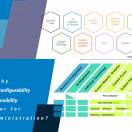Packaged Solutions make happy customers successful
When Sabya Mitra founded SAP partner Renew HR in 2016, he knew he wanted to focus the business on SMB clients and on cloud solutions since the two seemed a perfect match.
“I always thought the large enterprises have the money to get the best solutions they want, but because they didn’t have the resources to get a world-class solution, SMBs always needed to sacrifice. Cloud helped them reach there; it has leveled the playing field,” Mitra said.
SAP SuccessFactors for Small & Midsize Business (SMB) market – Part 2
One of the main objectives of HR Transformation is to improve the effectiveness of the process. And the processes only can be effective if a number of people use the process. We have seen in the past that great processes remain largely underutilized as wider user adaptation hasn’t happened.
For the SMB organizations, it is essential that they have a great user acceptance and the process/product that they are using is highly adaptable without much user training and change management effort. These organizations simply don’t have those additional dollars to spend here.
SAP SuccessFactors for Small & Midsize Business (SMB) market – Part 1
Gartner defines SMBs by the number of employees and the amount of annual revenue they have. The attribute used most often is the organization’s employees. Small businesses are usually defined as organizations with fewer than 100 employees, while midsize enterprises are those having 100 to 999 employees. The second most popular attribute used to define the SMB market is annual revenue. Small business is usually defined as organizations with less than $50 million in annual revenue; a midsize enterprise is defined as organizations that make more than $50 million but less than $1 billion in annual revenue.
How SAP SuccessFactors customers can take advantage of big data HR Analytics
In a previous blog, we explored the requirement for an ‘HR Health Check’ or ‘HR Audit’ and the best way to assist organizations in constructing a future ‘HR Roadmap.’ It is important to understand what is a business case? and how an HR Business Case helps to address the vital challenges faced by CHROs to obtain funding to support the previously created ‘HR Roadmap.’
HR Business Case and why it is essential to have one
In a previous blog, we explored the requirement for an ‘HR Health Check’ or ‘HR Audit’ and the best way to assist organizations in constructing a future ‘HR Roadmap.’ It is important to understand what is a business case? and how an HR Business Case helps to address the vital challenges faced by CHROs to obtain funding to support the previously created ‘HR Roadmap.’
HR Health check & Roadmap
HR Health Check or HR Audit may be best described as a holistic overview of a client’s existing HR processes. It includes systems, organizational roles and responsibilities, service delivery, and UX.
HR Health checks or HR Audits can be run using several different methodologies, including but not limited to, diagnostic questionnaires, interviews, surveys, and workshops together with business and IT stakeholders.


















